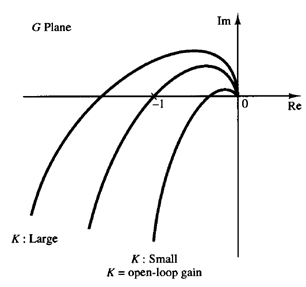SKEDSOFT
Phase and gain margins

Fig: 1 Polar plot of

Figure 1 shows the polar plots of G(jω) for three different values of the open-loop gain K. For a large value of the gain K, the system is unstable. As the gain is decreased to a certain value, the G(jω) locus passes through the -1 j0 point. This means that with this gain value the system is on the verge of instability, and the system will exhibit sustained oscillations. For a small value of the gain K, the system is stable.
In general, the closer the G(jω) locus comes to encircling the -1 j0 point, the more oscillatory is the system response. The closeness of the G(jω) locus to the -1 j0 point can be used as a measure of the margin of stability. (This does not apply, however, to conditionally stable systems.) It is common practice to represent the closeness in terms of phase margin and gain margin.
Phase margin: The phase margin is that amount of additional phase lag at the gain crossover frequency required to bring the system to the verge of instability. The gain crossover frequency is the frequency at which |G(jω)|, the magnitude of the open-loop transfer function, is unity. The phase margin γ is 180° plus the phase angle Φ of the open-loop transfer function at the gain crossover frequency, or

Figures 2(a), (b), and (c) illustrate the phase margin of both a stable system and an unstable system in Bode diagrams, polar plots, and log-magnitude versus phase plots. In the polar plot, a line may be drawn from the origin to the point at which the unit circle crosses the G(jω) locus. The angle from the negative real axis to this line is the phase margin. The phase margin is positive for γ > 0 and negative for γ <0. For a minimum phase system to be stable, the phase margin must be positive. In the logarithmic plots, the critical point in the complex plane corresponds to the 0 dB and -180° lines.
Gain margin: The gain margin is the reciprocal of the magnitude |G(jω)| at the frequency at which the phase angle is -180°. Defining the phase crossover frequency ω1 to be the frequency at which the phase angle of the open-loop transfer function equals -180° gives the gain margin Kg:

In terms of decibels,
